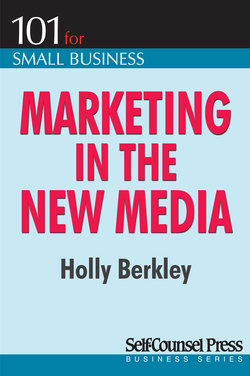Читать книгу Marketing in the New Media - Holly Berkley - Страница 4
На сайте Литреса книга снята с продажи.
1 An Overview of New Media Marketing
ОглавлениеEver since I can remember, television has been the leader in providing a medium for advertisers to get their messages out to the largest audience in the most effective way possible. However, since the creation of TiVo and other digital video recorder (DVR) technology, advertisers are growing increasingly concerned that viewers are simply skipping their very expensive commercial spots altogether. Combine this with the fact that traditional media channels such as television, radio, and print publications are no longer the only media choices for news and entertainment, and you may find yourself entering some unfamiliar territory to get your marketing message out to your target audience.
Today’s new media technology is allowing for more consumer control than ever before, giving the public complete control over what content they see and when they see it. As a result, this change in consumer expectations and media use has forced advertisers to rethink their entire marketing strategy. Big businesses can no longer depend on interruptive marketing tactics such as placing commercials in the middle of your favorite television show. Instead, advertisers have to think strategically about how to incorporate their marketing message into the content that potential customers are actively seeking.
Today, more than 1.4 billion (internetworldstats.com, March 2008 people worldwide are online, tuning in to their favorite websites, reading email, chatting online, listening to streaming music, playing games, and downloading videos.
According to a March 2006 study by the Association of National Advertisers and Forrester Research, 78 percent of 133 national advertisers surveyed believe traditional advertising methods have become less effective in the past two years. Of those surveyed, 70 percent believe that the growing use of DVRs and video-on-demand services will further reduce and even destroy the effectiveness of the traditional 30-second television commercial. As a result, overall network spending has declined, while advertisers invest significantly more in Internet advertising opportunities (La Monica, March 2006).
This trend towards new media marketing has forced even the major networks — NBC, CBS, ABC, and FOX — to build an online component into their advertising model in order to keep advertisers happy. All the major networks have now launched online components of their top shows in order to give advertisers a better return on investment — and to give results that can be tracked.
ABC is allowing users to download popular shows such as Desperate Housewives and Lost the day after they air on prime time. Although the audience may be smaller than those who tune into the larger screen, the new medium is already proving more effective to advertisers who have the opportunity to sponsor the entire online version of the show, as opposed to sharing the more crowded television version which typically includes eight minutes of commercials for a 30-minute show. The other benefit to advertising on the web is that users currently do not have the option to fast-forward through the commercials.
NBC announced they will be tying in custom web-based content with their most popular shows such as The Office, Law & Order: Criminal Intent, and The Tonight Show with Jay Leno. In addition, they are working on co-branding contests and editorial sections between top websites such as iVillage.com (recently acquired by NBC) with Today and Access Hollywood (Newcomb, May 2006).
But will users really watch television shows online? As more and more flat screen and high definition televisions enter more homes, advertisers wonder if users will actually download shows to their laptops and home computers.
The answer is yes. Consumers are willing to watch their favorite shows online. In fact, according to Arbitron Internet Media, more than 45 percent of all Americans have listened to audio or watched videos on the Internet at some point. According to the same study, 30 million Americans listen to or watch Internet streams every week.
When CBS streamed more than 15 million live broadcasts of the 2006 March Madness, the sheer numbers proved beyond a doubt that users are willing to view web content online. According to CBS SportsLine, more than 1.3 million people signed up for the free service and visited the site around 5 million times during the NCAA Tournament. The advertisers as well as the network were more than pleasantly surprised by the massive turnout online (La Monica, April 2006a).
However, I want to stress that this book is not simply about buying ads online. Truly effective Internet marketing is not about simply moving a 30-second commercial that was once on television or radio to the web. Internet marketing is much more complex than this. With that said, the complexity of new media should not be seen as an obstacle or intimidate you. Rather, it is a fresh new playing field where almost anything can be tested and implemented — at often a fraction of the cost of traditional media campaigns. This new media opens up exciting new options to reach consumers on a more effective and personal level than ever before. These new forms of marketing are much more accountable, and thus cost-effective, than any other form of advertising.
